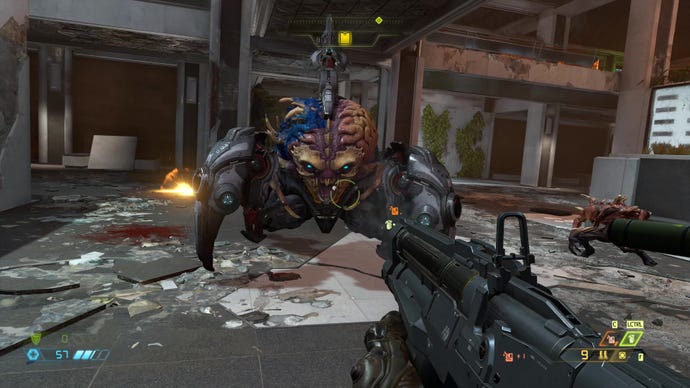Doom At 30: The evolution of Doom through its first levels
What the opening level of every mainline Doom game says about its place in FPS history
Video game openings have always been a source of fascination for me. As a player, you're excited by the prospect of the game to come - the sights you'll see, the challenges you'll face - and first impressions can make or break your entire perception of what a game is versus the one you had stored in your head before switching it on. For video game creators, however, a new beginning is often racked with questions. What, exactly, do you choose to show players first? How will you introduce them to something they've never seen before? And if that game is successful, how do you keep reinventing that first impression across what could be several decades?
In revisiting every mainline Doom game to celebrate its 30th anniversary this month, it's clear that even id's iconic shooter has wrestled with how to answer these question, and the ways it's tried to reinvent itself over the years paints a captivating portrait of a series trying to move with the times. Nowhere is this more apparent than in its opening levels. Played in close succession, crushing 30 years into not even quite three hours, what emerges isn't just the evolution of one of the all-time great PC games, but also a potted history of the FPS. So join me as we chart Doom's rise, fall and rebirth through the lens of its first stages.
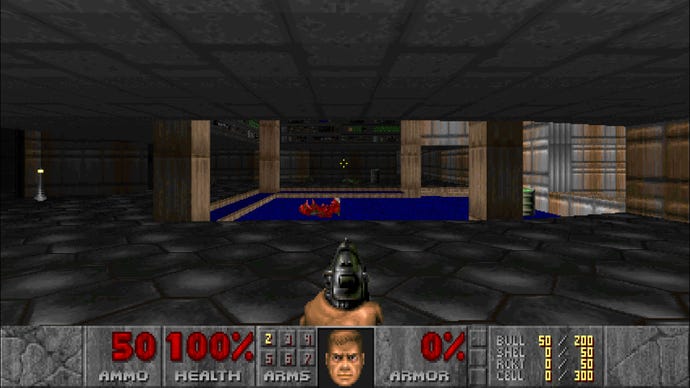
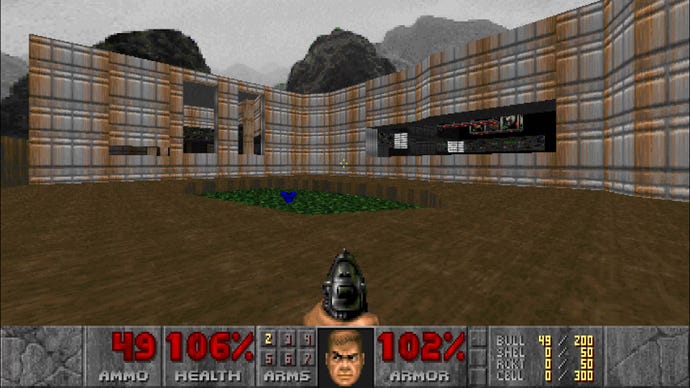
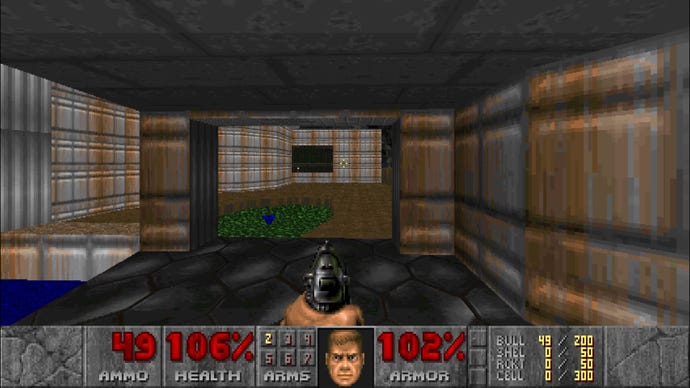
I've written before about how Doom II was one of my formative gaming experiences growing up, but this is the first time I've actually gone back to play the original Doom from 1993 - and what I'm most surprised by is the brevity of that initial E1M1 Hangar level. The opening room is completely devoid of enemies until you go through the first door, giving you ample time and space to acclimatise to its controls, and serving as an intake of breath before the slick red pixel butter to come. But for all its initial simplicity, this is still a level that's packed with secrets and high-level design choices.
Switches are tucked away in corners that seemingly do nothing unless you're tearing about the place at 100mph and glimpse the brief new doorways they've opened up. There are patches of wall with slightly different texture work to them, opening up even more new paths with a tap of your space bar. It also teaches you that bullets will land even if you're not on the same horizontal plane as the enemy you're firing at, and if you're smart, you might just be able to get more powerful guns out of sequence. It packs a lot into a level that, by its own par time estimation, should only take 30 seconds to complete, and it sets the template for what's to come just a year later in Doom II: Hell On Earth.

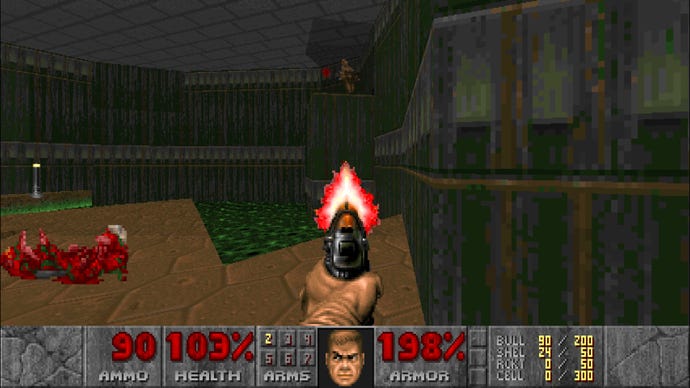
Doom II's opening level is similarly brief and short-lived, coming with another 30 second par time. As before, the simple S shape of its corridors looks simple at first glance, but this, too, has a lot more going on behind the curtain. For starters, you don't have to even engage with the two zombiemen standing there in front of you, at ease and unaware. You can turn around and go backwards round the corner to find the humble chainsaw, an essential back-up weapon that doesn't require any ammo. Indeed, the fact that those zombiemen are oblivious to your presence at first also heralds a vital new lesson - that it's possible to get the jump on these bozos to get the upperhand.
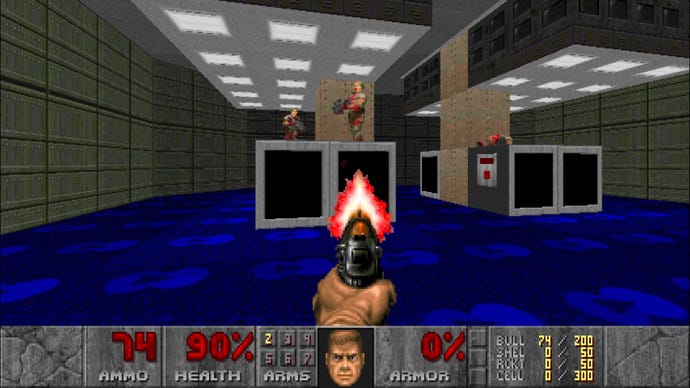
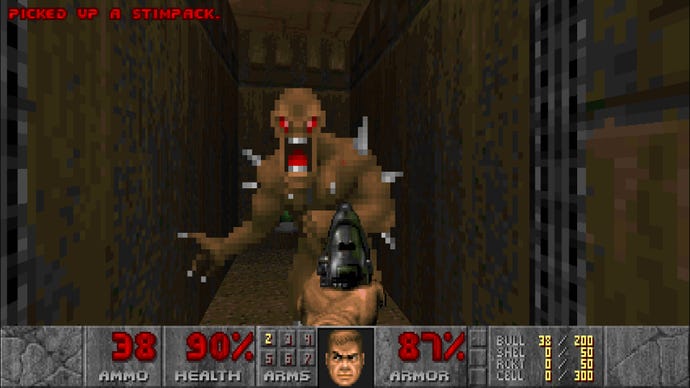

It also still amazes me you can get over half of Doom II's entire arsenal in this first level if you know where to look, but Doom II gives and it takes. Even this early on, it's not afraid to turn some of its secrets against you, preventing a perfect 100% completion rate if you mess up. Hit the switches in its second main enemy room in the wrong order, for example, and they'll both sink into the floor as enemies platforms are brought down to eye level, forever sealing off the one that would have opened a secret cavity in the wall. It's the kind of 'learning by doing' attitude that many of its contemporary NES games had in spades back then, but it also instils the idea that, hey, there are rules to be broken here, and you'll be rewarded for it if you're good enough.
Skip forward a few years to 1997 and Doom 64 arrives on the scene to bring its unique flavour of first-person shooting to consoles. This is another first-time playthrough for me, and oh god, I hate it already. It tries to pull the same trick as Doom II by giving you a second weapon instantly, but it makes the mistake of giving you the usually hard-earned shotgun instead of the chainsaw, instantly making your pistol redundant. Even firing it feels yucky. There's no kick, no oomph, and every zombieman goes down with a single, uninspiring thud because you've given me the shotgun too early, goddamnit, and now everything is insultingly easy. Worse, it's easy by design. And the Pinkys! Pinkys come in their droves, mowed down by the limp nose of your shotgun, and it doesn't feel right. The hierarchy of enemy types feels weird and out of wack.
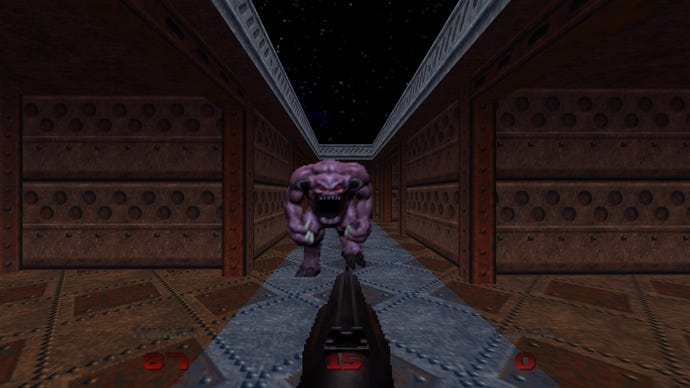
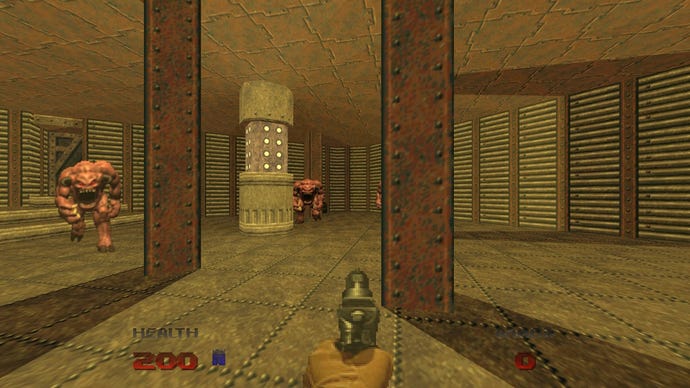
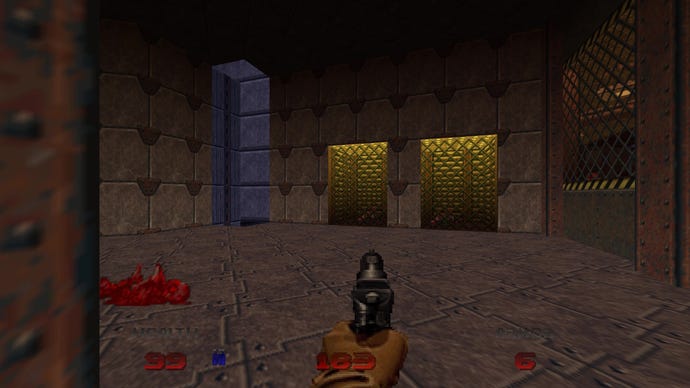

It does a good Berserk punch blood splatter, I'll give it that, but it's not enough to save what's otherwise quite a disorienting maze of beige and yellow walls. There's no clean throughline from start to finish. There are too many rooms, too many dead-ends that loop you back through empty, corpse-strewn corridors, and too many lifts (and crikey, they do love a lift in this game). Its secrets don't feel like secrets either, as half of them emerge within your direct eyeline, no dashing or thought required. To me, this feels like a game that's simply pandering to its player base. We know you love the shotgun, we know you love the Pinkys, new custodians Midway cry, so here they are right up front. But it loses all sense of drama and build-up in the process. It's probably just as well this came out a few months before GoldenEye 007 did in 1997, otherwise I suspect it would have been absolutely savaged.
It's quite a stretch before we then get another Doom game - the divisive Doom 3 in 2004 - but man alive, you can really see seven years of FPS evolution come to bear here. During the intervening years, we not only had Half-Life and Halo come out, but over on consoles we also had Metroid Prime and several Resident Evils, all pushing the boundaries of what people now expect from a story-driven first-person shooter. It's still a few months yet before Half-Life 2 will rewrite the rulebook once again at this point in the year, but one thing is clear: horror is the sub-genre du jour here, as Doom 3 isn't so much a pure FPS about blasting savage little pixel demons three ways to Friday, as it is a "mature" first-person horror game that also happens to have some shooting in it.
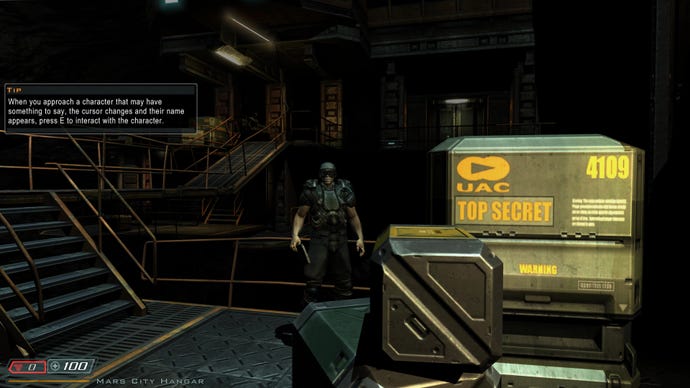
I say "mature", because looking back at it in the cold hard light of 2023, it's almost a perfect time capsule of that earnest, self-serious 'games can be art, too' mentality that defined so many games of the early 00s, and gosh darn it if they weren't going to try their darnedest to make sure the general public took them just as seriously as books and films (and it's probably no surprise to learn that this was the game 2005's Doom film was mostly based on, too). The bridge between what was "art" and entertainment had never been closer in 2004, but I think Doom 3 ultimately represents a different kind of growing pain - and that's where does Doom itself fit in this newfangled frontier of FPS games?
It suddenly seems embarrassed to even hand you a gun before it's explained its story, its lore, what the UAC are and all the nasty experiments they've been conducting somewhere deep inside the facility you've just arrived on. From the moment you start a new game file, it takes approximately ten minutes (ten!) before you get your first gun, and another nine (NINE!) before you have anything to actually shoot. That's almost 20 minutes of story exposition, listening to grumpy NPCs giving you orders to go to this place then that place, managing an ever-dwindling flashlight bulb, and collecting audio logs and PDA diaries that now tell you the secret to opening its locked supply caches instead of just letting you figure it out on your own. "What the heck am I playing?" I wrote in my notes. "Dead Space?"
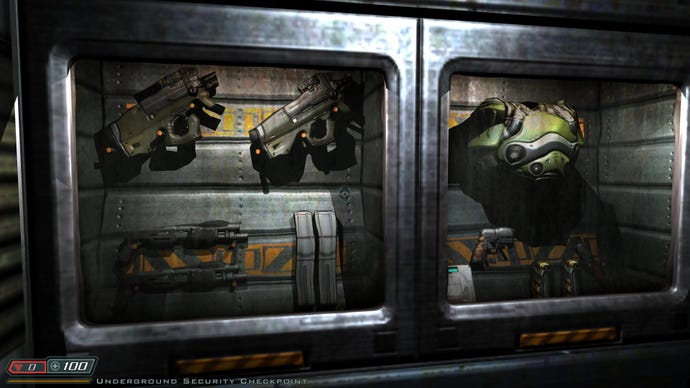
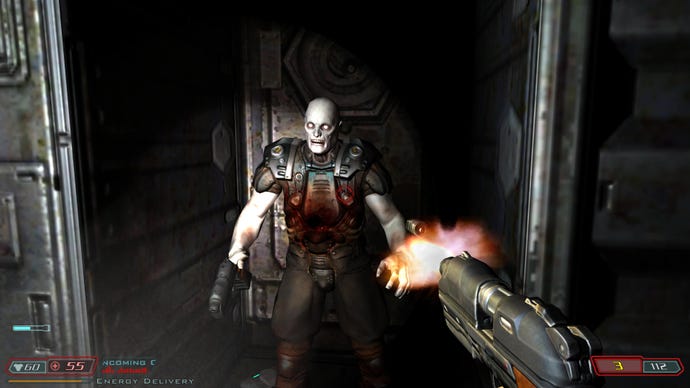
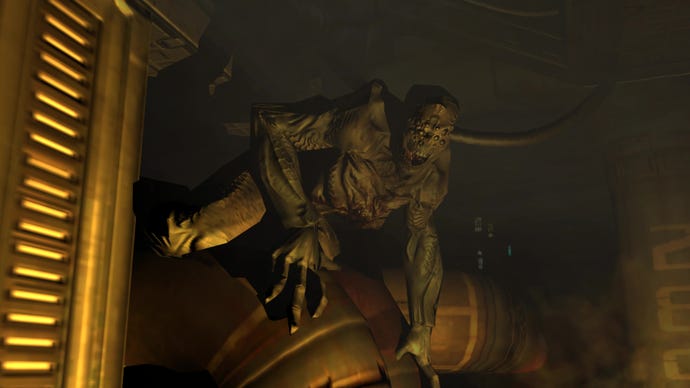
Dead Space, of course, didn't exist yet. That would come four years later, but holy Cacodemons on a stick Batman, this ain't the same Doom I've just been spit-balling through for the last 15 minutes! This is more like a Resident Evil game prancing around in a Doom skin suit, because when the demons do finally pitch up, there's barely any room to shoot or move out the way of incoming fire. I'm doing the unthinkable - standing still - to gun down zombiemen and imps because that's all I can do in these tiny, narrow, linear corridors. This is a serious, grown-up demonic invasion happening in real time now, you dummy. There's no running off to find 'secrets' and cheat your way to bigger and better guns anymore. Your cries of idclip are meaningless here!
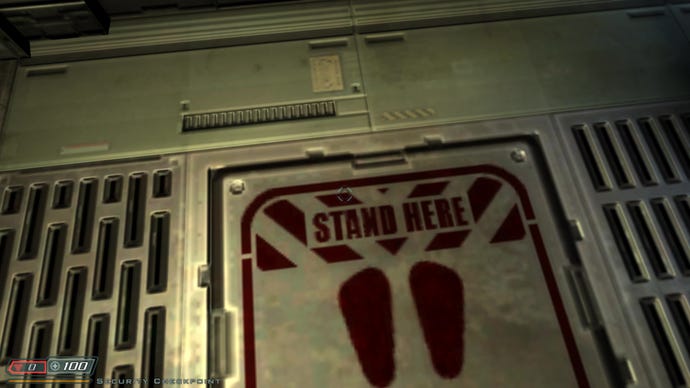
It is, admittedly, quite a good horror game. It's intense, the radio cries of your rapidly dying comrades is very full-on, the lighting is harsh and brash and it's not afraid to get right up in your face during that first level to really show you its saliva-slicked teeth. There's even an imp that does a headcrab-style lunge at you upon opening a door. But I wouldn't say it's Doom. There is no time for such childish, frivolous things in 2004, and it takes quite a long old while before someone musters the courage to break out the toy box again and really embrace what makes Doom, well, Doom.

Over ten years go by until finally we get Doom (2016), a game whose opening level is a more surprising mesh of its horror-fuelled past and gleeful, demon-smashing roots than I'd perhaps realised. As Doomguy awakens from a stone coffin after a summoning ritual goes awry, you're immediately greeted by screeching zombiemen in your face, and a desperate (possibly naked?) scrabble to grab a nearby pistol and fire your way to freedom. It's much more hair-raising than I remember, but once you're able to take a breath, it cuts to the chase in the same way old Doom did back in the 90s. There's a light sprinkling of exposition as you suit up and work out exactly what in seven hells is going on, but within minutes you're learning about Glory Kill finishers and how slamming through your opponents on the way to your next kill is your only route to survival. It still gives you the shotgun perhaps a smidge too early if you ask me, but it does at least make you use the pistol first before relegating it to your infinite ammo back-up option.
But the thing that Doom (2016) gets right, and now feels completely unashamed about, is giving its players room to breathe again. Battle arenas are rife with platforms and ramps and ledges to vault, and there's a chaotic energy to every scrap as imps and zombie marines ping-pong off walls and clamber around after you. It feels very much like old Doom again, albeit through the lens of twenty years' worth of multiplayer deathmatches. There's a light twist of horror in the blood and the gore and the rasping death rattles of your rank and file zombie fodder, but this is a game that revels in the fight of it all.

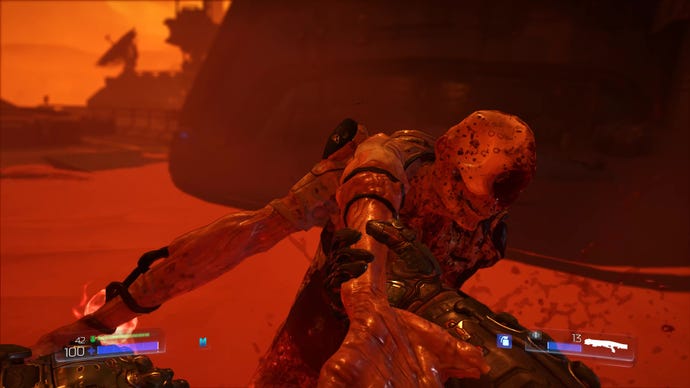
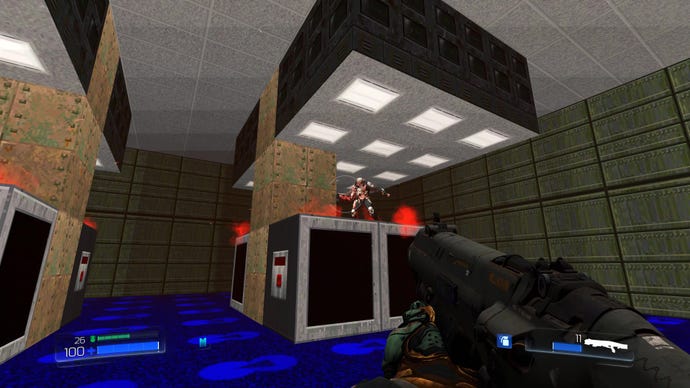
There are still secrets dotted about, with enough time having passed that they're now mostly retro nods to its source material (see above right) than actual secret rooms and compartments. But the bulk of its exploration is geared around more mundane things like weapon mod upgrades, map stations, and finding the bodies of elite guards with Praetor token USB keys on them you can use to upgrade your suit - things that old Doom had no need for. But in this age of genre pilfering, where everything is sort of an RPG now whether it likes it or not, Doom joins the fray with gusto. The crucial difference between this and Doom 3, however, is that it doesn't lose its own identity in the process.
Then, there's 2020's Doom Eternal, which now knows so wholly what it's about that it doesn't even bother giving you a pistol anymore. Instead, your shotgun has been relegated to pistol status here, which is arguably what Doom 64 should have done all those years earlier. But there's good reason to get the shotgun out the way early, because in addition to the returning Glory Kills, there's the revamped chainsaw to get to grips with now, letting you carve demons in two to have them spill out fresh ammo stocks like a gribbly, blood-spewing pinata. You're given plenty of opportunities to engrain this new combat rhythm of shoot/punch/chainsaw into your WASD fingers, too, thanks to its plentiful, and arguably even larger battle arenas, which ramp up so fast with different, previously late-game enemy types - going from gaggles of zombiemen to full on armies of shotgun guys, imps, arachnotrons and cacodemons - that you can't help but wonder, 'Bloomin' heck, if it's going this hard already, what other horrible things are lying in wait further on?' (A question that Doom 64 failed to ask its players by only bringing the Pinkys forward).

Doom Eternal has finally learned the art of modern day sequelcraft - building on what came before without forcing a contrived reset of your abilities, while also upping the stakes to thrilling and satisfying effect. It still bears some less welcome hallmarks of contemporary game design - your AI companion Vega will merrily chat to you in voiceover while marking up objective locations on your HUD, for example - but these sanded, blood-slicked edges do also create a wonderful kind of contrast when they butt up against some of its more overt game-yness. Whereas secret levers and switches were just ordinary parts of the scenery in Doom (2016), here you'll spy big glowing 1UP heads through cracked walls, spinning yellow question marks behind metal grates, and other faintly meta visual cues that - to my mind, at least - hark back to the rule-breaking winks of its 90s forebears. This place isn't meant to make any kind of serious sense, it seems to suggest, so why not just have fun with what we've prepared for you instead?
It's the same kind of confidence that Doom (1993) and Doom II had in spades all those decades ago with their snake-like secret passageways, deliberate blackouts when you so much as sneezed on a key and doors that only opened when glanced right with a southeasterly wind behind you, and it's heartening to see the current id Software team manage to rekindle that same playfulness 30 years later. It might be cliched to say that Doom has been to hell and back during the intervening decades, but it's clear right from that very first level of Doom Eternal that this is a series that's finally found its feet again. It's successfully spun a new beginning for itself, and I can't wait to see where it takes us next over the next 30 years.

